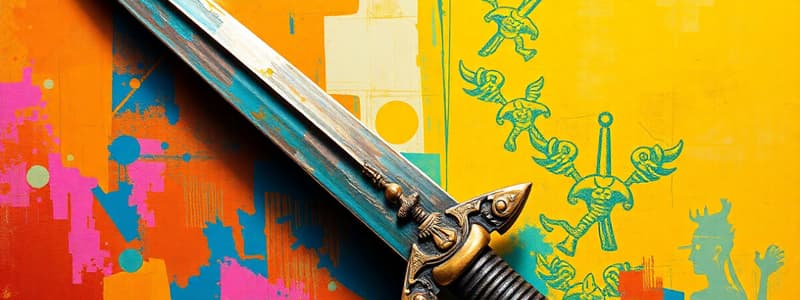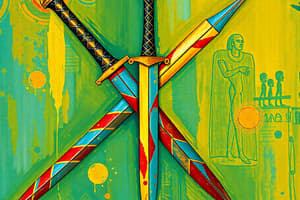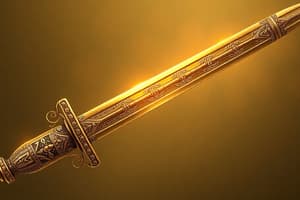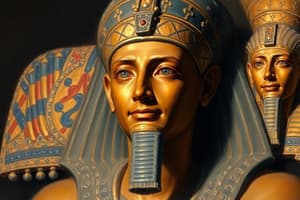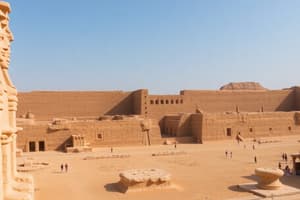Podcast
Questions and Answers
What significant artifact was discovered by Egyptian archaeologists in September 2024?
What significant artifact was discovered by Egyptian archaeologists in September 2024?
- An ancient scroll
- A stone tablet
- A gold necklace
- A gleaming bronze sword (correct)
Which ancient Egyptian pharaoh is associated with the sword's insignia?
Which ancient Egyptian pharaoh is associated with the sword's insignia?
- Ramses II (correct)
- Hatshepsut
- Cleopatra
- Tutankhamun
What does Peter Brand theorize about the function of the military fort?
What does Peter Brand theorize about the function of the military fort?
- It served as a trade center.
- It was primarily a burial ground.
- It had an on-site weapons production area. (correct)
- It was a royal palace.
What elements indicate that the ancient fort housed a self-sufficient community?
What elements indicate that the ancient fort housed a self-sufficient community?
What was the potential purpose of the sword’s engravings according to historians?
What was the potential purpose of the sword’s engravings according to historians?
What material was used by ancient Egyptians for eye protection?
What material was used by ancient Egyptians for eye protection?
How long did Ramses II reign as pharaoh of ancient Egypt?
How long did Ramses II reign as pharaoh of ancient Egypt?
What did the limestone blocks found at the site mention?
What did the limestone blocks found at the site mention?
Flashcards
Ramses II's Sword
Ramses II's Sword
A gleamimg bronze sword discovered in an ancient Egyptian military fort, marked with the insignia of Ramses II, suggesting it belonged to a high-ranking military official.
Tell Al-Abqain
Tell Al-Abqain
A 3,200-year-old military fort in northwest Egypt that was inhabited during the reign of Ramses II. It is a critical site for understanding ancient Egyptian military life and practices.
Kohl
Kohl
A dark, black powder used by ancient Egyptians as a cosmetic and eye protection from the harsh desert sun. It was applied using a special tool.
Pharaoh's Insignia
Pharaoh's Insignia
Signup and view all the flashcards
On-Site Weapons Production
On-Site Weapons Production
Signup and view all the flashcards
Grain Storerooms
Grain Storerooms
Signup and view all the flashcards
Baking Ovens
Baking Ovens
Signup and view all the flashcards
Ramses II
Ramses II
Signup and view all the flashcards
Study Notes
Egyptian Bronze Sword Discovery
- A gleaming bronze sword, inscribed with the insignia of Ramses II, was unearthed in Tell Al-Abqain, a 3,200-year-old military fort.
- The sword, buried for over 3,000 years, retains its reflective shine.
- It was found within a small room in the fort's mud barracks.
- The presence of Ramses II's emblem suggests the sword belonged to a high-ranking military official.
Significance of the Sword
- The discovery suggests the fort was well-defended and possibly had a weapons production area.
- Historian Peter Brand believes the sword was a royal gift to a prominent officer.
- Pharaohs used inscriptions on weapons as status symbols, showcasing wealth, power, and generosity.
Tell Al-Abqain Fort
- The fort provided insights into daily life of its occupants.
- Storerooms for grain and ovens for baking were unearthed, implying self-sufficiency.
- Remains of large pots with fish and animal bones suggest a diverse diet.
- Personal items, like bead necklaces and kohl applicators, offer glimpses into personal lives of soldiers.
- Two limestone blocks with the names "Bay" and Ramses II were also found.
Ramses II
- Was one of Egypt's most powerful pharaohs, ruling for 66 years (1279-1213 BCE).
- Ramses II, also known as Ramses the Great, was the third pharaoh of the 19th Dynasty.
- Famous for his military achievements, expanding Egypt to areas like Syria and Sudan.
- Known as the "builder pharaoh" for the numerous temples and monuments he commissioned.
Studying That Suits You
Use AI to generate personalized quizzes and flashcards to suit your learning preferences.
Description
Explore the remarkable discovery of a bronze sword inscribed with the insignia of Ramses II at the ancient military fort of Tell Al-Abqain. This artifact, dating back over 3,200 years, provides valuable insights into the military practices and daily life of the Pharaoh's era. Learn about the significance of the sword as a symbol of power and status in ancient Egypt.
